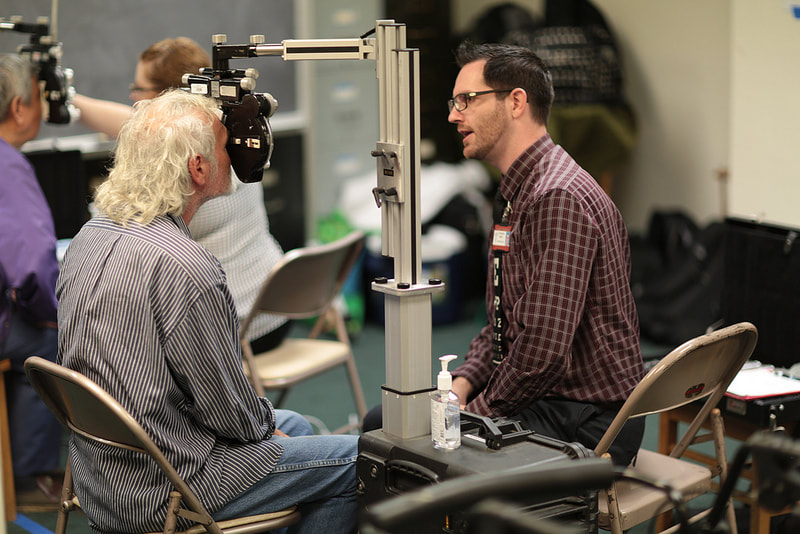We Each Have Autonomy
and We're In It Together
Relational Ontology and the
Physician-Patient Relationship
Dec. 27, 2018
a short note by
|
Jonathan Kopel, M.D. - Ph.D. Student,
Texas Tech University Health Sciences Center (TTUHSC) |
Jay McDaniel, Ph.D.
Center for Process Studies, Open Horizons |
Summary: The physician-patient relationship remains a sacred and intimate relationship fostering open communication while respecting patient autonomy. Several studies showed improved patient satisfaction and treatment outcomes with physicians trained in aligning their personality and communication styles with a patients’ preferred methods for acquiring and processing information. Together, these results indicate that the physician-patient relationship and personality fit within the philosophical scope of a relational ontology, which views entities as a composite of inherited properties and its influences or relations with other entities. Overall, the physician-patient relationship and personality exist as rich relational entities producing profound impacts on communication and patient outcomes.
Short NoteWithin the medical profession, the physician-patient relationship remains a sacred and intimate relationship fostering open communication while respecting patient autonomy. Without this therapeutic alliance, patient confidence and compliance with treatment goals would be impossible to maintain. Several studies showed improved patient satisfaction and treatment outcomes with physicians trained in aligning their personality and communication styles with a patients’ preferred methods for acquiring and processing information related to their diagnosis and treatment (1,2). As Gillian Clack explained, “Some individuals prefer being given the straightforward facts in a clear, concise, and practical manner, others prefer factual information in a caring manner, others prefer having the overall picture delivered in a personalized manner, and others prefer the discussion of logical options by a competent practitioner in a manner that respects their intelligence” (3). Ineffective communication leads to poor management and coordination across the medical profession. Thus, maintaining personality alignment between physicians and patients is crucial for both effective communication and treatment (4,5). Together, these results indicate that the physician-patient relationship and personality fit within the philosophical scope of a relational ontology perspective.
First described by the philosopher Harold H. Oliver, relational ontology views the ontological status of all entities in the universe, including human persons, as a composite of its own properties and its influences or relations with other entities. Indeed, an entity’s own properties are its responses to the influences of others, spontaneous or habitual. When they are habitual, they become “properties” of the entities at issue. Thus, in a relational ontology, an entity is not an isolated being that can exist independently of its actual world, but is instead a process – a gathering into unity -- of its many relations with that world. It is, in the words of the philosopher Alfred North Whitehead, a concrescing subject. Concrescence is Whitehead’s name for the activity of becoming concrete and particular, becoming “real” in the moment at hand, in response to the influences of other entities. In Whitehead’s relational ontology, concrescence occurs in the smallest units of actuality, the quantum events in the depths of atoms, for example; and also in human beings and other animals. Moment by moment, human beings are not mere objects in a mechanistic world but rather concrescing subjects whose very existence consists of receiving influences from others and responding to them. The responses consist of feelings, thoughts, hopes, fears, and dreams relative to what is received from the world. Physicians and their patients provide an obvious example. The physician is a concrescing subject and so is the patient, and as they interact with one another they become who and what they are amid the interactions. This does not mean that they are totally dependent on one another. They have relations apart from their relations with one another, and they have autonomy of their own. But it does mean that part of their very existence, their very being, emerges in and through their interactions, their relations. In a relational ontology, then, “relations” are essential. This essentiality is illustrated, not only in human to human relations but also in other domains of life: written language, for example. In written language, each sentence is composed of two primary elements: letters and words. Each letter is distinguished by its unique sound while each word is distinguished through the unique combinations of letters. In forming a sentence, words are then arranged according to the syntax of the language, where its meaning can be fully understood. At each level, the full meaning of the sentence cannot be reduced to simply letters or words. Although words and letters have individual properties, it is only when the relations between the letters and words are properly combined and organized that the sentence fully come into being. So far we have offered two examples of relations: inter-human relations on the one hand, and relations between words in a sentence on the other. These examples illustrated two kinds of relations: internal and external. Here we are building upon the tradition of Western philosophy. In the history of philosophical thought, three positions have been proposed to explain the scope and nature of relation: internal relations, external relations, or a combination of both (6). Internal relations are those relations essential for the very being of an object. If the relation were to disappear, so would the object. For example, a wife would cease to be a wife unless related to a husband. This view of relation implies that every object, however distant, relates to everything else. On the other hand, external relations are relations which are not part of the essence of an entity at issue. A prime example of external relations is written language. As just described, the relations among the letters of a sentence are imposed by grammatical and spelling rules and can be interchanged without eliminating their individual existence. In a relational ontology such as that of Oliver or Whitehead, internal and external relations both play a role. In Whitehead’s philosophy, for example, the present is internally related to past events, in that past events and its relations to them are part of the present. However, the past is externally related to the present, in that the character of past events precedes, and is independent of, its incorporation into the present. Nevertheless, in both perspectives – Olivers and Whiteheads – there is a primacy to international relations, in that they constitute the very being or existence of what an entity (a concrescing subject) is in the present moment. In a certain sense the entire universe is built of relations, both internal and external. As Michael Ovenden eloquently puts it, “There is this complementary [between the 'conceiver' and the 'conceived'], so that the reality we seek lies neither in us nor in the world, but in the relationships between us and the world. It is the structure of relationships that is the transcendent thing” (6). We turn back, then, to the relation of the physician and patient. In each instance the very heart of their relationship depends on the way they interact personally: that is, from the vantage point of their distinctive personality. A person’s “personality” is the evolving totality of his or her relations with (1) the world (friends, family, society), (2) the natural world (including the body and brain), (3) his or her prior self, and, so Whitehead would argue, (4) with the living whole of the universe, whom he names God. Each person’s personality is unique, be it the personality of the physician or that of the patient. And yet, in their relationship with one another, something is added to each that would not exist without the other. They have their unique personality, and yet their personalities are, as it were, inter-personal or inter-subjective, partly dependent on the other. Without personality, relationships would have little meaning or value and reduce themselves to indifferent interactions of physics and chemistry. The task of the physician is to recognize this interdependence and, at the same time, to respect the autonomy of the patient. Here the language of “internal” and “external” relations can help. The physician needs to receive the patient’s personhood and personality into his or her own life in an empathic way, thus establishing an “internal” relation with the person, and the physician must also respect the autonomy of the person, discerning when and how the patient might be best served in a hands-off way, by referrals to other clinical departments or institutions. Sensitivity to personality itself, in ways that are empathic and respectful, remains an independent prerequisite for any meaningful physician-patient relationship. A patient exists independently whether he or she has formed a therapeutic alliance with a physician or other caregiver. However, personality is continually shaped and molded through various biological, social, or environmental interactions. In short, the very concept of relationality and its attendant idea of personality, so emphasized in relational ontologies, is essential to humane physician-patient interactions. This does not mean that a physician must know all of a patient’s personality preferences in advance. It means instead that a physician must be open to who a patient is, at a personal level, in the immediacy of the moment, recognizing that a person’s personality may change over time. We physicians must constantly assess a patient’s personality since “our behavior can alter when we’re stressed. For these reasons it is not only unnecessary to know a patient’s [personality] preferences in order to conduct a consultation, but it could be misleading. For example, if you knew a patient had preferences for extraversion, intuition, and feeling, you might not pick up on the fact that today—possibly because he or she is coming to discuss potentially worrying test results—that patient is contained, relatively impersonal, and focused on hearing the detailed results of the test. What is important is to be able to tune into a patient’s current communication style” (7). Overall, the physician-patient relationship and personality exist as rich relational entities producing profound impacts on communication and patient outcomes. Thus, the deep relationships formed between physicians and patients are mirrors for the numerous and rich relational entities inherent throughout medicine and science. Beyond the medical profession, “there are relations all the way down, all the way up, and all the way out in every direction; you never reach something which is not just one more nexus of relations” (8). A relational understanding of physician-patient relations presupposes a relational universe, and a relational universe requires physicians to be relational in their approach to patients, in service to the Hippocratic oath, an oath of respect for human life, which is itself an invitation to relationality. |
References
1. Pollak KI, Alexander SC, Tulsky JA, Lyna P, Coffman CJ, Dolor RJ, Gulbrandsen P, Ostbye T. Physician Empathy and Listening: Associations with Patient Satisfaction and Autonomy. The Journal of the American Board of Family Medicine 2011;24(6):665-672.
2. Clever SL, Jin L, Levinson W, Meltzer DO. Does Doctor–Patient Communication Affect Patient Satisfaction with Hospital Care? Results of an Analysis with a Novel Instrumental Variable. Health Services Research 2008;43(5 Pt 1):1505-1519.
3. Clack GB, Allen J, Cooper D, Head JO. Personality differences between doctors and their patients: implications for the teaching of communication skills. Medical Education 2004;38(2):177-186.
4. Ha JF, Longnecker N. Doctor-Patient Communication: A Review. The Ochsner Journal 2010;10(1):38-43.
5. Ommen O, Them S, Pfaff H, Janssen CG. The relationship between social support, shared decision-making and patient's trust in doctors: a cross-sectional survey of 2,197 inpatients using the Cologne Patient Questionnaire. International Journal of Public Health 2011;56(3):319-327.
6. Oliver HH. A Relational Metaphysic. New York City, New York: Springer, 2013.
7. Allen J. Doctor-patient communication. BMJ 2005;330(7484):s36.
8. Rorty R. A World without Substances or Essences from Philosophy and Social Hope Philosophy and Social Hope. City of Westminster, London, England: Penguine Books, 2000.
1. Pollak KI, Alexander SC, Tulsky JA, Lyna P, Coffman CJ, Dolor RJ, Gulbrandsen P, Ostbye T. Physician Empathy and Listening: Associations with Patient Satisfaction and Autonomy. The Journal of the American Board of Family Medicine 2011;24(6):665-672.
2. Clever SL, Jin L, Levinson W, Meltzer DO. Does Doctor–Patient Communication Affect Patient Satisfaction with Hospital Care? Results of an Analysis with a Novel Instrumental Variable. Health Services Research 2008;43(5 Pt 1):1505-1519.
3. Clack GB, Allen J, Cooper D, Head JO. Personality differences between doctors and their patients: implications for the teaching of communication skills. Medical Education 2004;38(2):177-186.
4. Ha JF, Longnecker N. Doctor-Patient Communication: A Review. The Ochsner Journal 2010;10(1):38-43.
5. Ommen O, Them S, Pfaff H, Janssen CG. The relationship between social support, shared decision-making and patient's trust in doctors: a cross-sectional survey of 2,197 inpatients using the Cologne Patient Questionnaire. International Journal of Public Health 2011;56(3):319-327.
6. Oliver HH. A Relational Metaphysic. New York City, New York: Springer, 2013.
7. Allen J. Doctor-patient communication. BMJ 2005;330(7484):s36.
8. Rorty R. A World without Substances or Essences from Philosophy and Social Hope Philosophy and Social Hope. City of Westminster, London, England: Penguine Books, 2000.
















